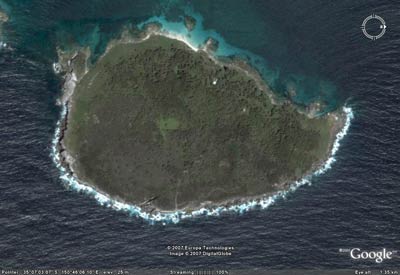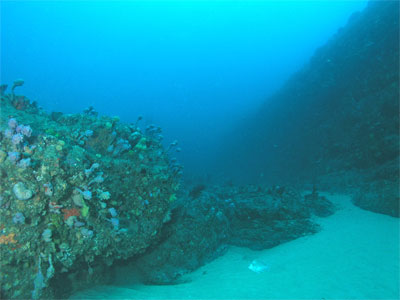Michael McFadyen's Scuba Diving - Pyramid Rock
 |
Bowen Island - Pyramid Rock is below the left side of the island
Note that north is to the right |
Jervis Bay is the largest real bay on the east coast of Australia. Covering an area of more than 126 square kilometres, the bay itself is one of the most untouched parts of the coast. The southern headland stretching down to Wreck Bay is part of Booderee National Park (formerly Jervis Bay National Park formerly Jervis Bay Nature Reserve) under the control of the Federal Nature Conservation Department (at least I think that is their current name), it may be Environment Australia - it, like the name of the park, keeps changing. The northern headland is Commonwealth land used as a naval firing range while a large proportion of the remaining shoreline was promised many times as a NSW national park by two former Ministers for the Environment and was finally proclaimed, quite stupidly, also as Jervis Bay National Park. At least now they have different names.
Likewise, the bay and surrounded coastal waters were announced many times as about to be proclaimed as a marine reserve but this took so long to happen, most believed that it never would. Before it was established, a draft plan was published in mid-1994 setting out the proposed zones for the reserve. It was not established. The current ALP NSW Government (in 1997) promised to make Jervis Bay a marine park (together with the Solitary Islands) and finally passed legislation to enable this to occur. The park was proclaimed but the consultation process on the marine park was pathetic, with no publicity given at all in scuba diving publications nor sent to dive clubs. There is more information at the Marines Parks Authority - Jervis Bay page.
Anyway, the headlands and Bowen Island protect the bay although there is still quite a large entrance. Bowen Island sits just off the southern headland and in reality is the southern headland of Jervis Bay. There is a small passage for small boats between the island and the southern headland but extreme care must be taken at all times. Bowen Island has some great dive sites, especially on the northern to south-eastern sides.
 |  |
| Looking north with the wall on left | The shear wall of Pyramid Rock on right
with the boulders on left - looking south |
If coming from Huskisson, travel out past the northern end of Bowen Island and head south to the southern end of the island. If coming from Murrays boat ramp, if the seas are absolutely calm and it is high tide qand you have a small boat (less than 6.5 metres), you can try the gap between the island and mainland, bu tbe careful. Keep to the southern side as this is deeper. Once outside the bay and head north east for a short distance to 35° 07.3888' S 150° 46.3204' E (using WGS84 as datum - see my GPS Page for more info). You will see a huge pyramid shaped rock on the shoreline at the south-eastern end of Bowen Island. Run in towards the rock and the depth sounder will show a rise from 34 metres to 23 metres. Drop anchor here, on top in a westerly, on the bottom in a southerly. Make sure you let out sufficient anchor line in northerly, westerly or similar winds in case the anchor slips off the top to the bottom.
This is a very attractive and spectacular dive site. The wall is amazing, about 10 or more metres high, extending at least 100 metres to the north and more than that to thes south and then west. From the sand bottom at 36 metres there are many large and small boulders. All along the wall there are small overhangs and cracks, with beautiful gorgonias everywhere.
On the sand, some very large boulders sit three or four metres high near where you have anchored, with sponges and more gorgonias. The sand itself is home to hundreds of sea-whips, with everyone having two or more tiger anemones living on them. Tiger anemones look like a cross between an anemone and a nudibranch and are one of the most attractive animals in the ocean. Definitely the best place in NSW to see them. In between the boulders there are schools of bastard trumpeters, yellowtail, seapike and many species of leatherjackets. I have also seen firefish in amongst the rocks and eastern blue devilfish under the walls.
You may also see kingfish, bonito and other pelagics on this site. Fishlife is normally quite good, but can sometimes be sparse. However, it is a spectacular dive site where even if you see no fish, it is still interesting.
A great dive location for the more experienced diver.
| 
 v6.00.307 © 2003-2005
v6.00.307 © 2003-2005